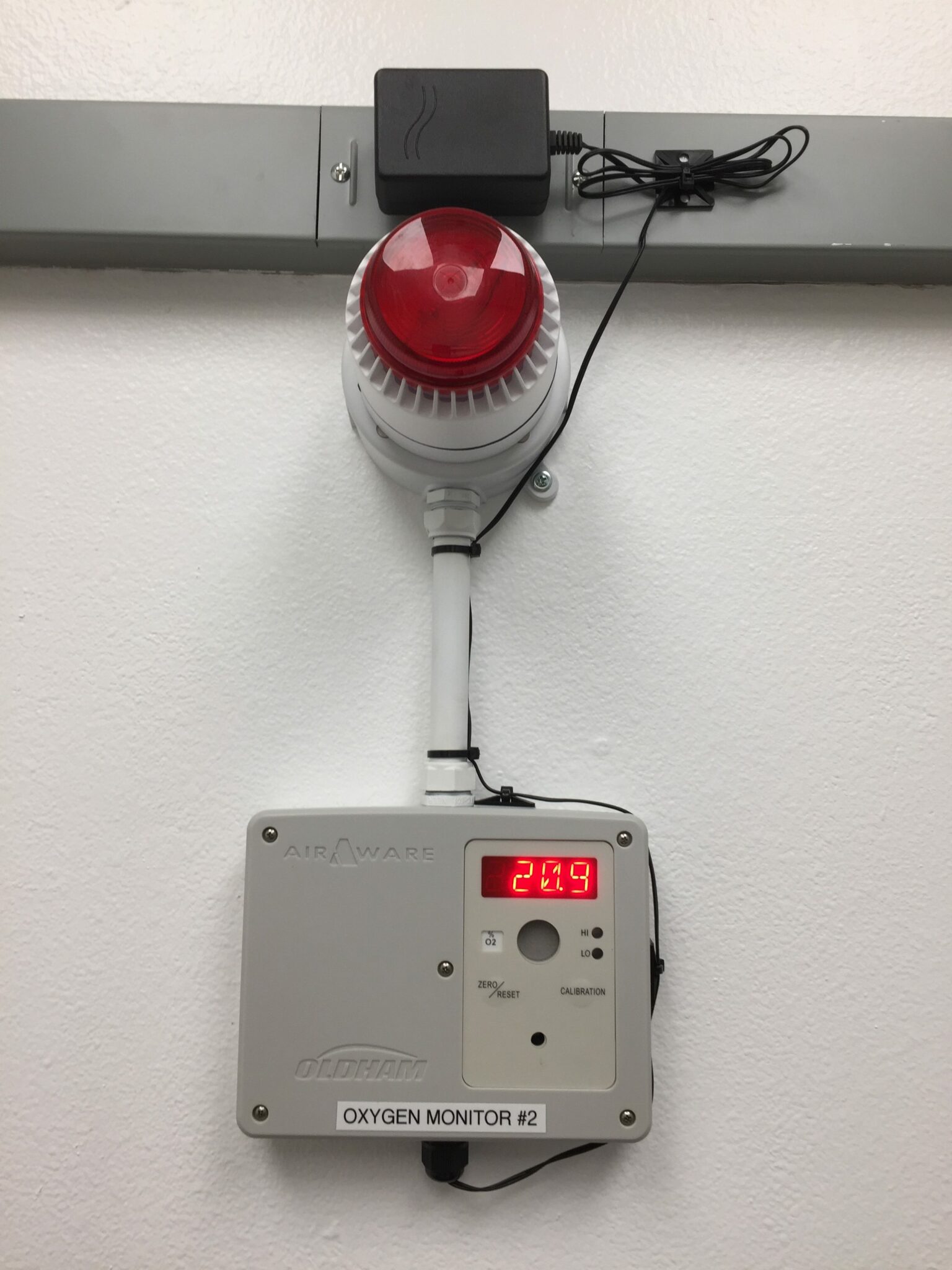After installing our first Laser Powder Bed Fusion Additive Manufacturing system, we learned a lot, and while he was at PADT, Dhruv Bhate kindly wrote up a series of blog posts on what we learned.
Here are the articles:
How can you minimize safety risks in powder-based metal 3D printing?
This is the second half of my third post in a 5-part series discussing things we learned installing a metal 3D printer (specifically, a laser powder bed fusion machine). If you haven’t already done so, please read the previous posts using the links below, in particular, part 3A which is a prequel to this post. I also recommend reading my post on the difference between reactive and non-reactive alloys in the context of this process.
- Part 1: Equipment
- Part 2: Facilities
- Part 3A: Safety Risks
- Reactive & Non-Reactive Metal Alloys in Laser Powder Bed Fusion (supplement)
In the previous post, I identified four main risks associated with operating a laser-based powder bed fusion metal 3D printer such as the one we use at PADT, a Concept Laser MLab Cusing R. In this post, I address three of these risks in turn and first discuss how the risk can be prevented from manifesting as a hazard (prevention) and then address how it can be mitigated in case it does result in an incident (mitigation). I will deal with the fourth risk (environmental damage) in the next post. As with the previous post, my intent is to inform someone who is considering getting a metal 3D printer and not be comprehensive in addressing all safety aspects – the full list of disclaimers is at the end of this post.
If you prefer, you can register for a webinar to be held on July 26 @ 2pm EDT (US) where I will be summarizing all 5 parts of this blog series. Register by clicking on the image below:
Risk 1: Fire and Explosion
1.1 Prevention:
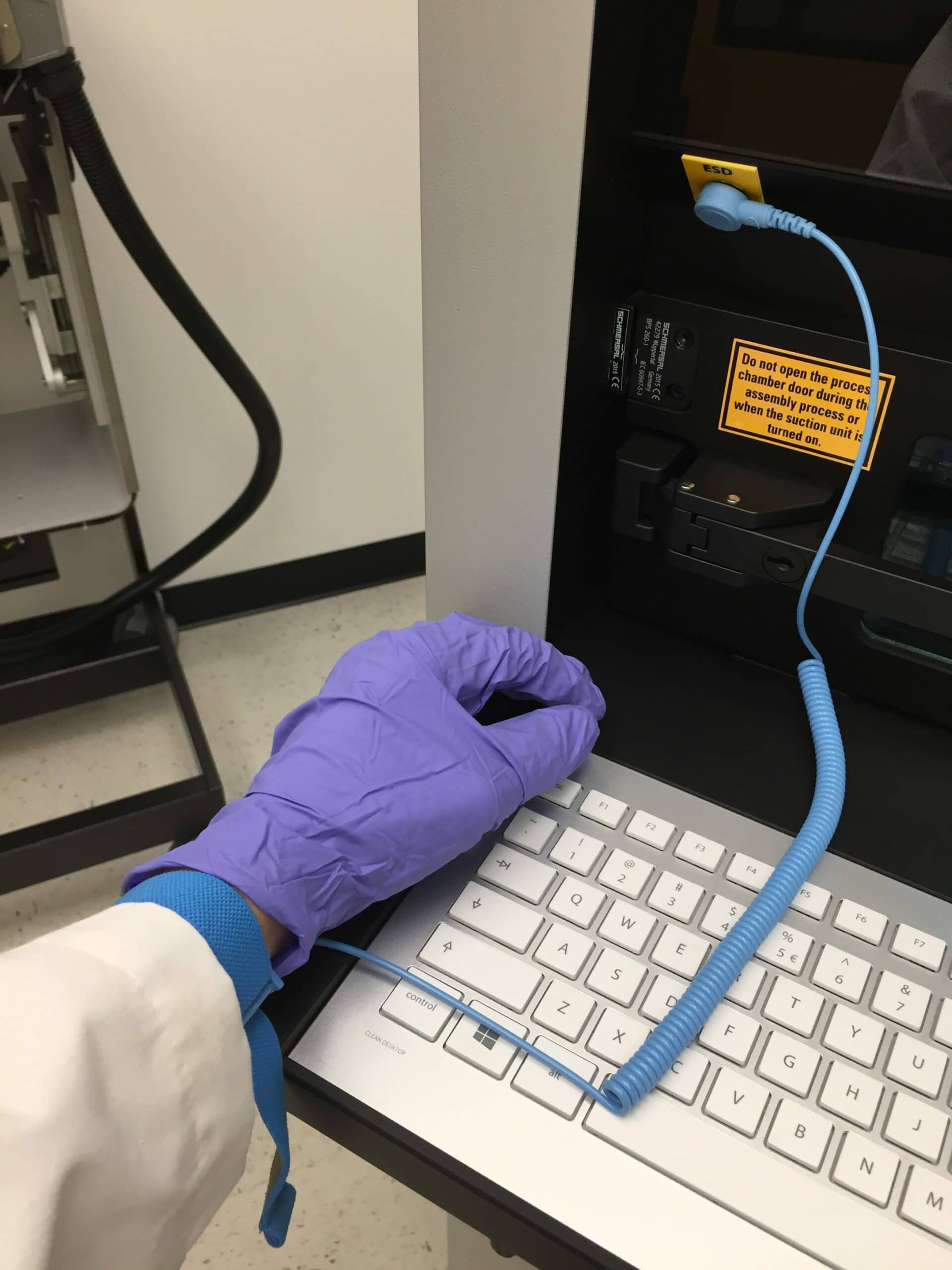
The key to preventing a fire is to remember that it needs three things (“the fire triangle”): fuel (metal powder or soot), an ignition source (laser or spark) and oxygen. While certified equipment is designed to operate in a safe manner when bringing the laser and the metal powder in contact by doing so in an inert gas environment, you as the operator, are responsible for avoiding any ignition sources when handling powder or soot outside of the inert environment. This is because two of the three aspects have been met: fuel (powder or soot) and oxygen (in the ambient). As long as basic risks are eliminated (sparking equipment, smoking etc.), the primary risk that remains is Electro Static Discharge (ESD) and thus the main piece of preventive equipment is an ESD wrist-strap, as shown in Figure 1, or equivalent ESD management methods.
It helps to appreciate the life cycle of the powder, as it goes from purchased jar to ending up returned as recycled powder (the majority of the powder), or in the wet or dry waste streams. This is shown in Figure 2. While this looks quite complex, coming out of the machine, the powder and soot only have 4 streams that you have to follow: the powder trapped in the part, the powder that you will recycle, the soot and powder trapped in the filter and finally, what will be cleaned with wipes and accumulate on gloves. While this is not comprehensive (internal hoses and shafts can also accumulate powder), these are the ones operators will deal with on a regular basis.
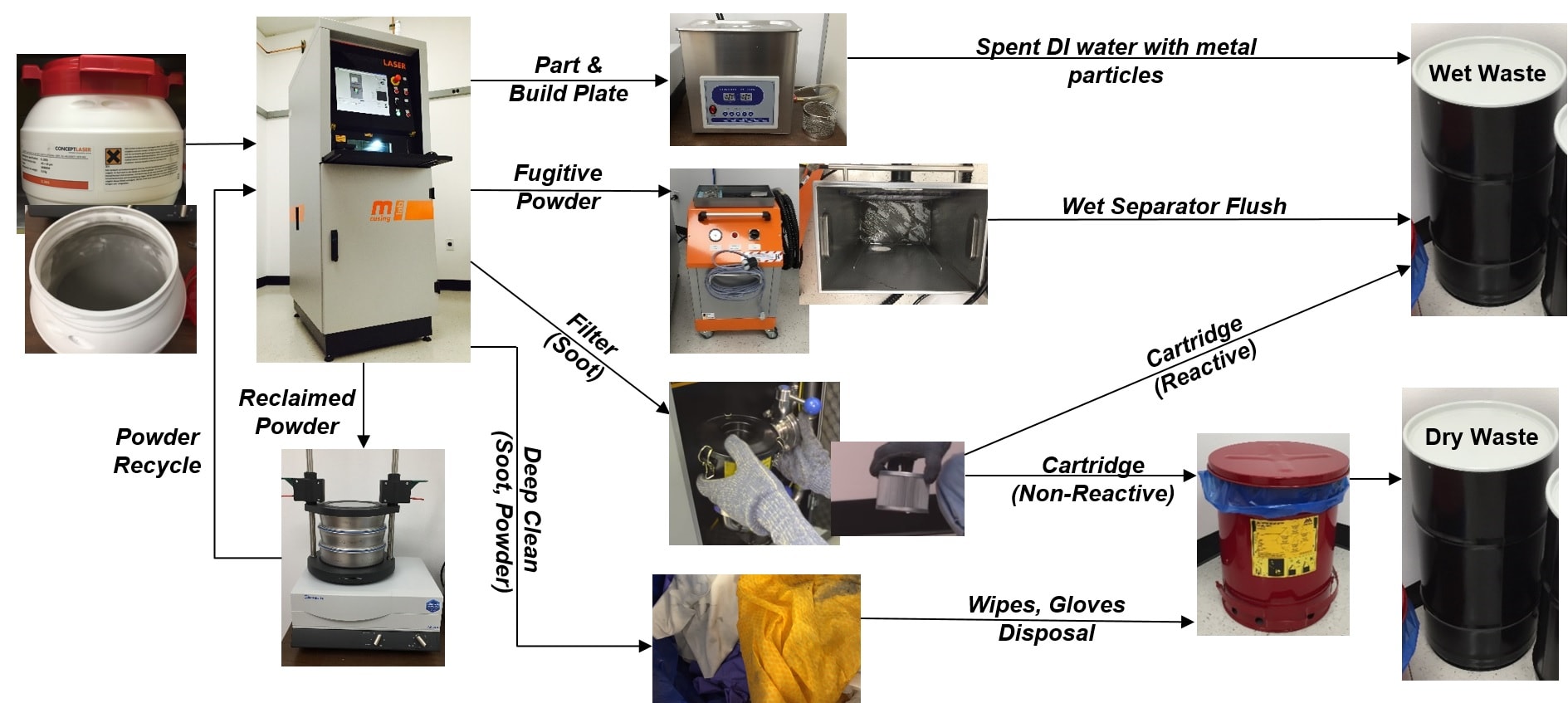
1.2 Mitigation:
In addition to doing everything we can to prevent fire, we also need to be prepared in case it does happen. There are (at least) four aspects that need to be considered, dealt with in turn below:
1.2.1 Personal Protective Equipment (PPE)
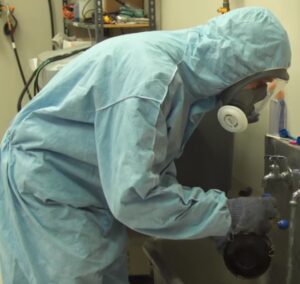
PPE is your self-defense in case of a fire and it is thus a critical element of the safety procedures you need to pay attention to and remember. Tasks are of varying risks, and our supplier recommends PPE for this process in three categories:
- Protective Clothing: A lab-coat that covers your arms, protective gloves, ESD strap if working with reactive metals
- Standard PPE: Respirator, nitrile gloves, face mask (if not integrated with respirator), ESD strap
- Extended PPE: Standard PPE PLUS
fire-rated bunny suit, fire-rated gloves (see Figure 3)
Below is a list of all activities that involve some risk of ignition (or inhalation, to be discussed in the next section) and the associated level of PPE recommended.
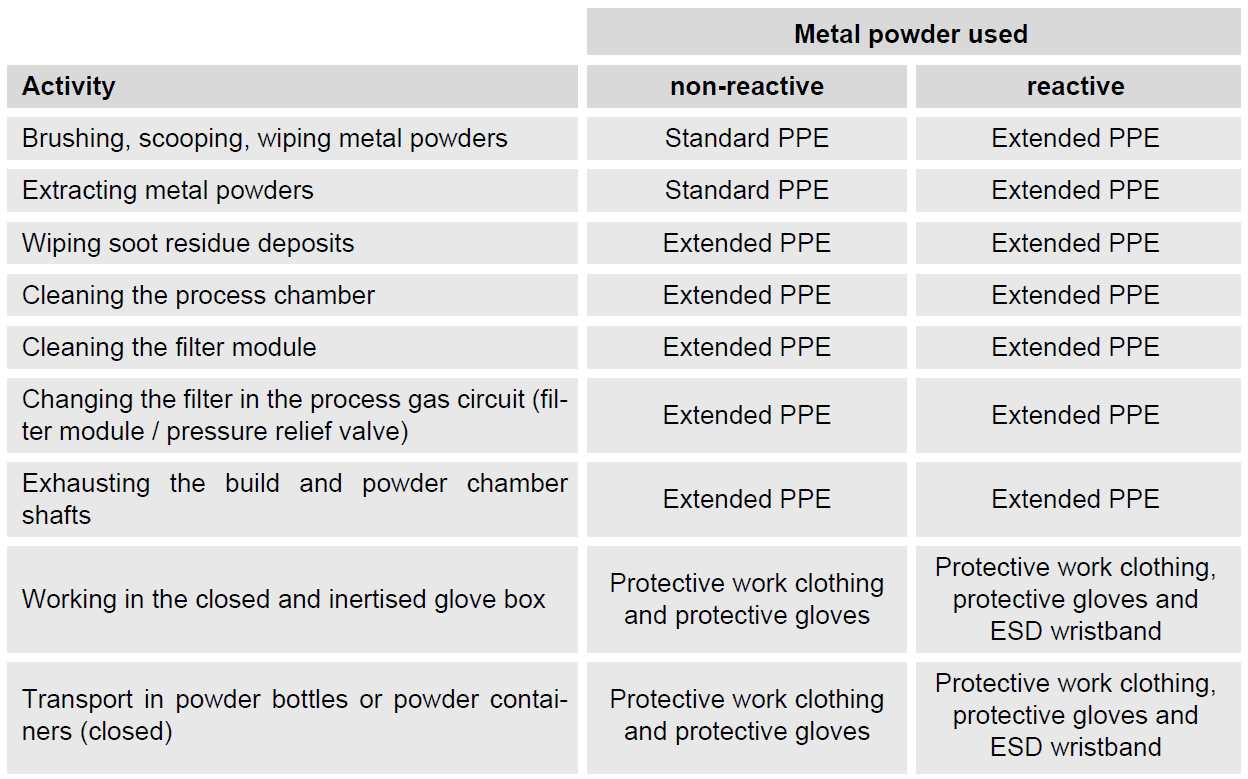
PPE can be tricky to implement consistently since as seen above, there are several tasks of varying risk levels that require different PPE. The conservative approach is to prepare for the worst case and wear Extended PPE at all times, but this can make you uncomfortable for long periods of time, reduce your mobility for some tasks, and introduce human error. Instead, here is the 3-step logic I use for remembering what to wear:
- Always wear gloves, goggles and protective clothing (lab-coat) when you work with the machine – make this a rule even for the simplest of tasks like using the keyboard and mouse
- If you are directly handling (i.e. not through a glove box) virgin or recycled non-reactive metal alloy powder (i.e. no reactive powders or combustion products), standard PPE is adequate
- For everything else, you need extended PPE
1.2.2 Fire Extinguishing
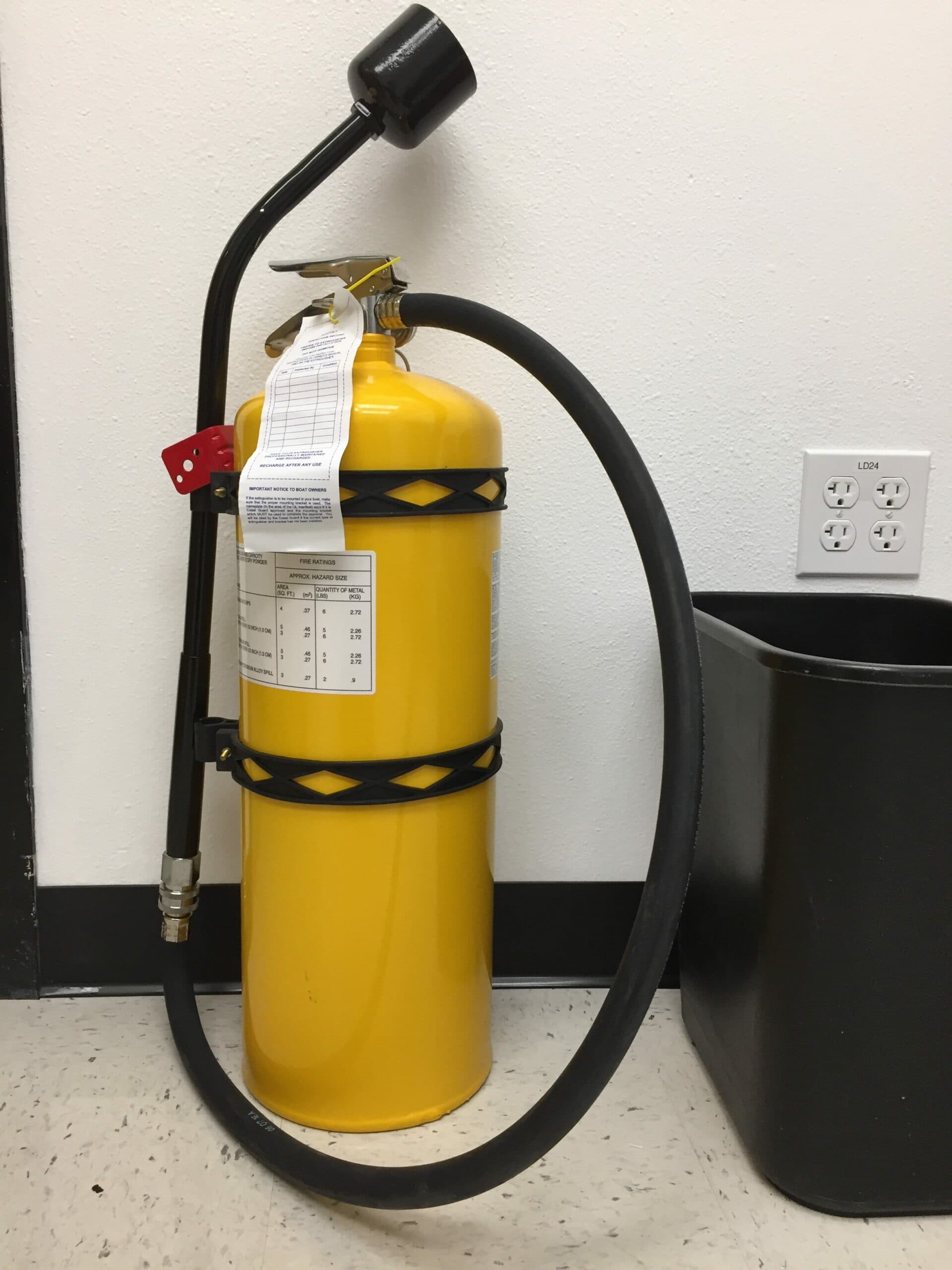
There are several recommendations for how to manage fire extinguishing. This is an area where you need to get your fire marshal to weigh in. What is clear is that water and CO2 are not safe choices for metal fires [NFPA 484 6.3.3.5(1)]. For extinguishing fires, the consensus is to use Class D fire extinguishers, such as the one shown in Figure 4. The fire extinguisher needs to be a Class D since this is the one rated for metal fires. The main training aspect is to ensure it is pointed down at the base of the fire rather than at it, followed by sweeping.
What to do with Water Sprinklers?: Water can be dangerous for metal fires, but the risk of not having any sprinklers may outweigh the risk of water exacerbating the fire. This is a function of how much risk you are introducing (amount of powder, proximity to other flammable sources, area surrounding the printer etc.) and is a decision best made together with your fire marshal.
1.2.3 Powder Storage
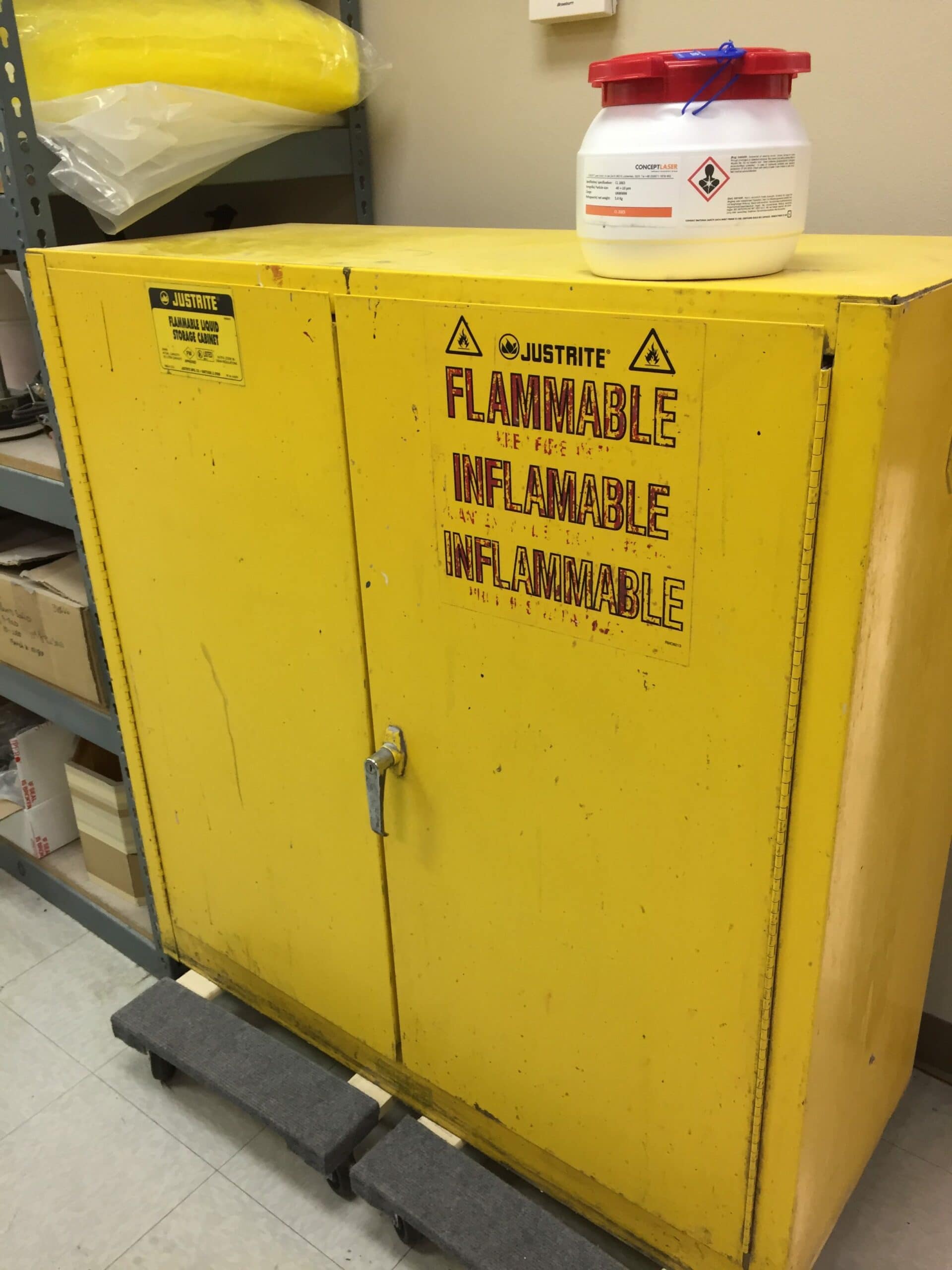
Powder storage will involve powder in unopened jars, opened jars as well as in the overflow collector which is on the machine. It is best to store opened and unopened jars in a flammable cabinet as shown in the adjacent figure. This is not essential for non-reactive alloys, but necessary for reactive metal alloys. For large quantities of reactive alloys, blast proof walls may be necessary – this is again something your city officials and fire marshal can guide you on, but do not neglect the importance of getting their buy-in early. Finally, most cities will require you to fill in some paperwork and show on a plan (map) where you are storing your powders, and what their composition is. This is to help inform the fire-fighters that there are metal powders onsite, and where they are located, in case of a building fire. If you do plan on working with reactive alloys in particular, you must involve your fire marshal sooner rather than later.
Risk 2: Powder Inhalation and Contact
2.1 Prevention
The main method of minimizing risk of powder inhalation is through the use of a respirator. These come in many forms, but the two most recommended ones for this process are respirators with built-in face-masks (as shown in Figure 3), and more preferable, the PAPR respirator, which delivers a positive pressure of air (for more information, read OSHA’s guide on respirators). N95 and higher respirator filters are recommended, though N100 are ideal.
Contact with powder is avoided by wearing gloves at all times when handling the machine. It is also useful to minimize risk of carrying powder outside the metal 3D printer area:
- Before starting work, put away watches, wrist jewelry and cell phones.
- Once done with the work, take off your protective coat and wash your hands and arms up to elbows before handling anything else.
- Consider installing an adhesive floor mat for you to step on as you walk out of the room.
2.2 Mitigation
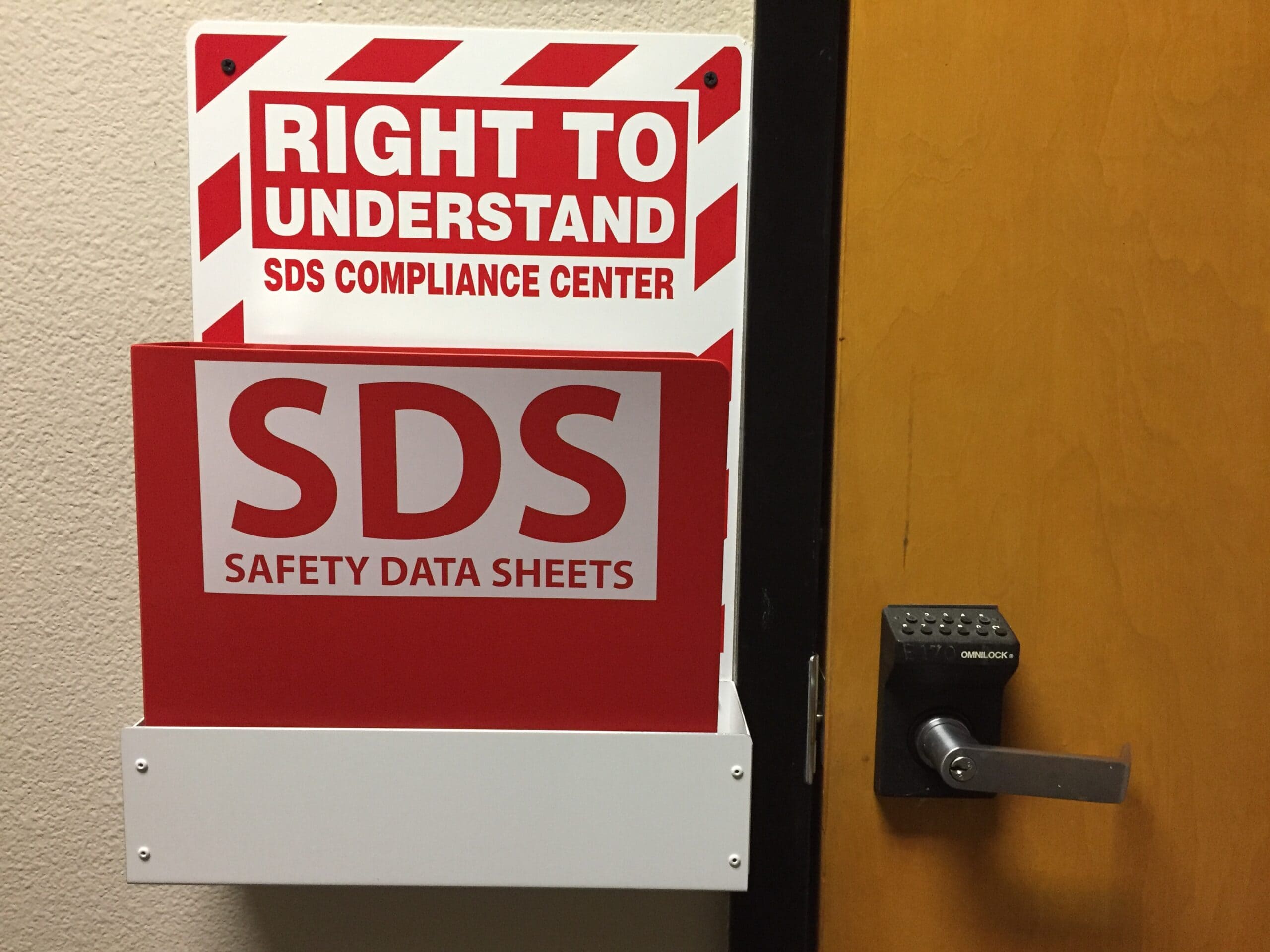
What to do in case of exposure is typically documented in the SDS (Safety Data Sheets), which is specific to the material in question, as shown in Figure 6 below. Ensure you have an SDS from your powder supplier for all powders you order, and collect them in a folder that is stored close to the entrance for easy retrieval, as shown in Figure 7.
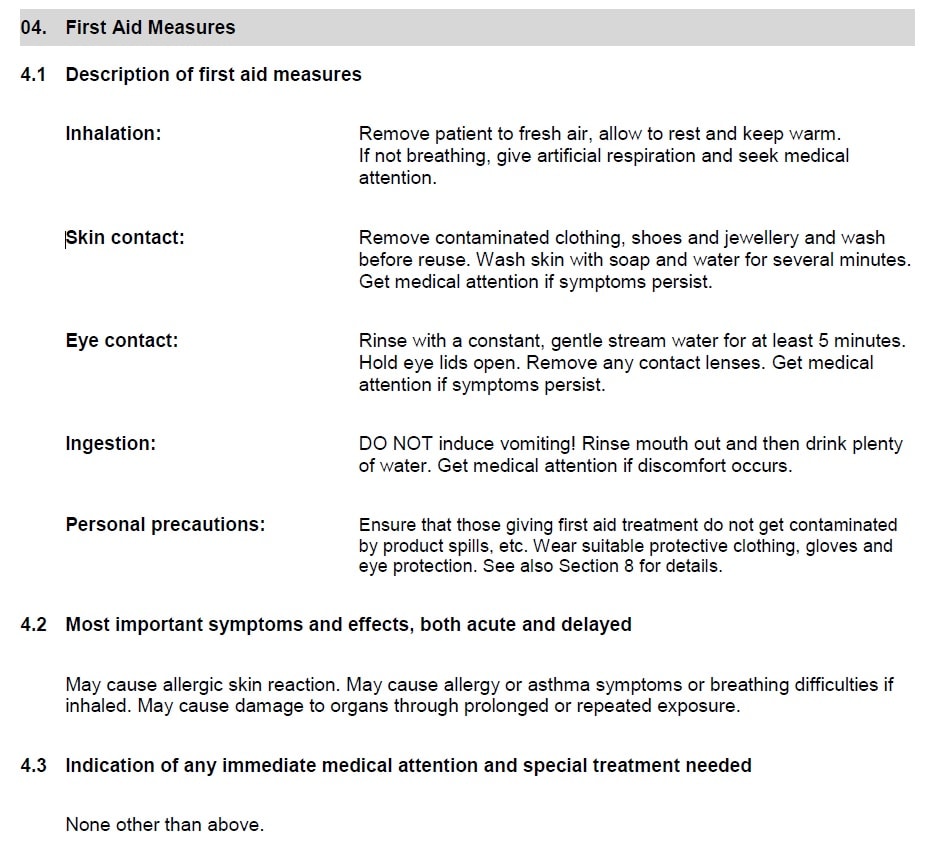
Risk 3: Inert Gas Asphyxiation
3.1 Prevention
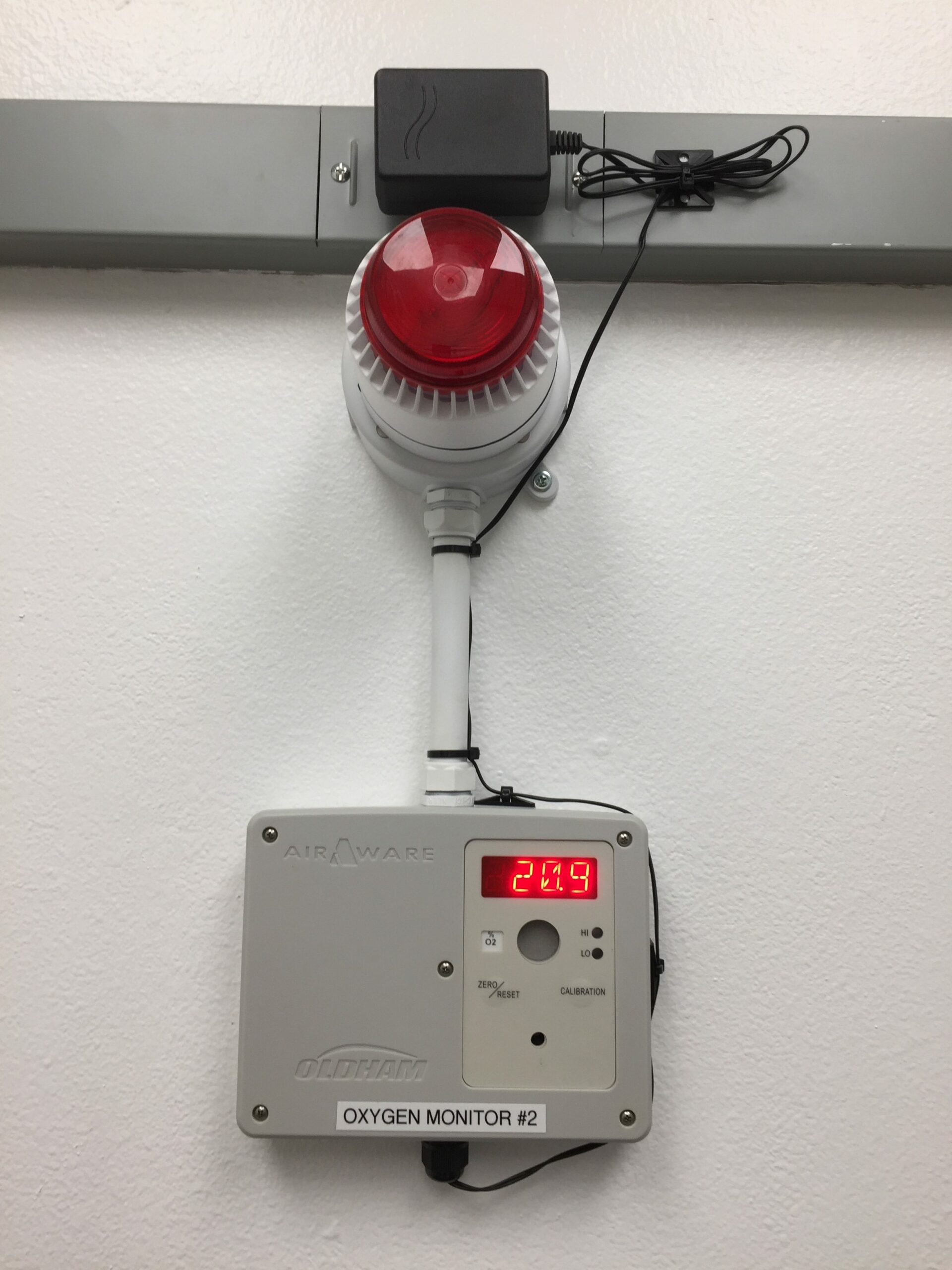
Inert gas (Nitrogen or Argon) is used for every build and is either stored in cylinders (argon) or piped from a generator (Nitrogen). Proper, leak-free facilities setup and equipment performance is essential, as is following recommended supplier maintenance on the equipment itself. An inability to drop to required oxygen PPM levels in the build chamber, or large fluctuations in maintaining them may be associated with a leak and should be addressed with the supplier before proceeding. Users of the equipment must know where the shut-off valves for the gases are, in case they need to turn it off for any reason.
3.2 Mitigation
The main mitigation device is an Oxygen sensor such as the one in Figure 7. This is an important sensor to have especially in confined spaces around any equipment that relies on inert gases, including the 3D printer and furnace. If oxygen levels fall below safe values, an alarm is triggered and immediate evacuation is required.
4. References
- National Fire Protection Association’s standard for combustible metals, NFPA 484
- OSHA on Oxygen Deficiency
- OSHA’s Guidance on Dust Explosions
- OSHA Respirator guide
- J.M. Benson, “Safety considerations when handling metal powders,” Southern African Institute of Mining and Metallurgy, 2012
- R. G. Goldich, “Fundamentals of Particle Technology,” Chapter 15, Midland IT and Publishing, UK, 2002
Disclaimers
- This is intended to supplement the supplier training you must receive before using the equipment and not meant to replace it – in case of conflicting information, your supplier’s training and equipment requirements override any discussion here. PADT and the author assume no legal responsibilities for any decisions or actions taken by the readers of this document.
- My personal experience derives specifically from the use of Laser-based metal 3D printing tools, specifically Concept Laser’s MLab Cusing R equipment. I expect majority of this information to be of use to users of other laser based powder bed fusion metal systems and to a lesser extent to Electron Beam systems, but have no personal experience to vouch for this.
- Local, state and federal regulations vary, and are important – partner with your local fire marshal (or equivalent authority) as a starting point and take them along with you every step of the way. If in the US, familiarize yourself in particular with OSHA’s guidance on dust explosions and NFPA 484, the National Fire Protection Association’s standard for combustible metals (links above).
~
Any other tips or ideas I have not covered, please let me know by messaging me on LinkedIn or by sending an email to info@padtinc.com, citing this blog post. I will be happy to include them in this post with due credit. My aim is only to add to the discussion, not be the last word on it – and I look forward to suggestions that can make operating this technology safer for all of us and the ones that rely on us coming home every day.
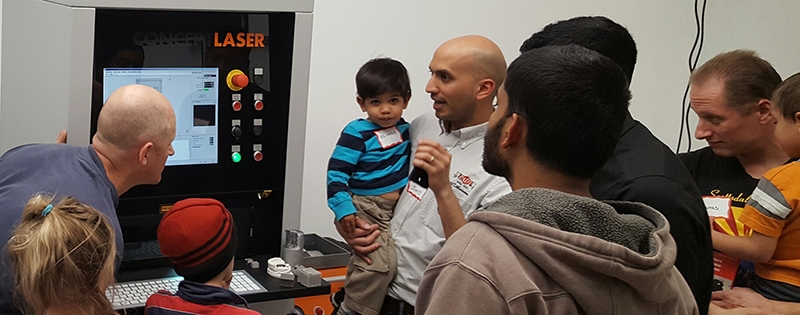
Continue Reading:

